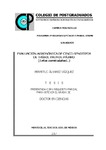Evaluación agronómica de cinco genotipos de trébol pata de pájaro (Lotus corniculatus L)
Abstract
En México, a excepción de la alfalfa y trébol blanco, no se conoce el potencial productivo de leguminosas forrajeras como trébol pata de pájaro (Lotus corniculatus L.). El estudio se llevó a cabo en el Colegio de Postgraduados, Montecillo, Texcoco, Edo. de México, de septiembre de 2014 a septiembre de 2016. El objetivo del trabajo fue realizar determinaciones productivas para conocer el potencial forrajero de cinco genotipos de la especie en mención. Las evaluaciones fueron realizadas cuando las praderas interceptaron un porcentaje de 90, 95 y 100 % de luz solar incidente, además de un intervalo que se mantuvo fijo, definido estacionalmente. Los tratamientos se distribuyeron en un diseño de bloques al azar en parcelas divididas con tres repeticiones, donde la parcela grande fue el genotipo y la chica el tratamiento. Los datos se analizaron con el procedimiento PROC GLM del SAS, y la comparación de medias se realizó mediante la prueba de Tukey con una probabilidad del 5 %. Todos los genotipos estudiados respondieron mejor a estrategias de manejo dependientes del porcentaje de luz interceptada, respecto a un corte fijo definido estacionalmente. El mejor genotipo fue el 202700, con rendimiento de forraje anual de 32,173 kg MS ha-1. En la estación de primavera, se registraron los mayores rendimientos de materia seca y coincidió con las mayores alturas de planta. En las estaciones de otoño – invierno se produjo la menor cantidad de forraje, no obstante, la relación hoja:tallo fue mayor. En el tratamiento del 95 % de luz interceptada se produjo la mayor cantidad de hoja. Los componentes botánicos – morfológicos tuvieron un aporte al rendimiento en el siguiente orden; hoja > tallo > material muerto > maleza. En conclusión, la cantidad de luz interceptada por la pradera fue la mejor estrategia de manejo a la cual puede ser cosechada la especie trébol pata de pájaro y ser más productiva respecto a un manejo considerando un intervalo de corte fijo, definido por estación. _______________ AGRONOMIC EVALUATION OF FIVE GENOTYPES OF BIRDSFOOT TREFOIL (Lotus corniculatus L.). ABSTRACT: In México, with the exception of Lucerne and white-clover, the productive potential of forage legumes such as birdsfoot trefoil (Lotus cornicultaus L.) is unknown. The study was carried out at the Colegio de Postgraduados, Montecillo, Texcoco, Mexico, from September 2014 to September 2016. The objective was to know the productive potential of five genotypes of birdsfoot trefoil (Lotus corniculatus L.) in terms of dry matter yield, harvested at different moments according to a light interception level. The harvest were made when the pasture reached an intercepted percentage of light of 90, 95 and 100 % incident light, including a fixed cut-off interval defined seasonally as a control. Treatments were distributed in a randomized block design in split plot array with three replicates. Data were analyzed with the procedure PROC GLM of the SAS, and mean comparison was made by the Tukey test with a probability of 5 %. All the genotypes studied responded better to management strategies dependent on the percentage of light intercepted, with respect to a fixed cut defined seasonally. The best genotype was 202700, with an annual forage yield of 32,173 kg DM ha-1. The most productive season was spring, where the highest plant heights were recorded. In the autumn - winter seasons there was the least amount of forage, however, the leaf:stem ratio increased. The largest amount of leaf was produced in the treatment of 95 % of light intercepted. The botanical - morphological components had a contribution to the yield in the following order; leaf > stem > dead material > brush. The amount of light intercepted by the meadow can be the best management strategy for harvesting birdsfoot trefoil and be more productive with respect to management considering a fixed cut off interval, defined by season.
Collections
- Tesis MC, MT, MP y DC [403]


